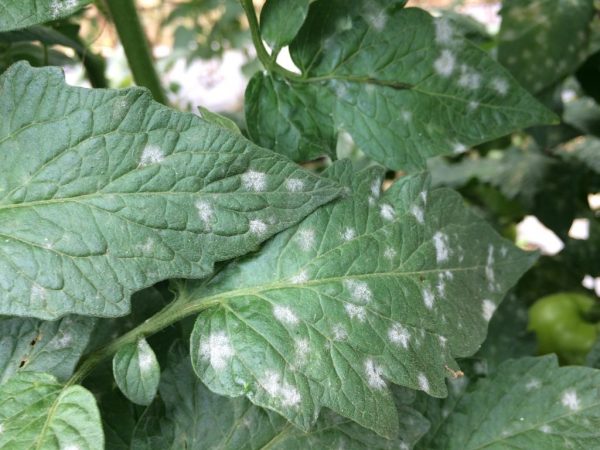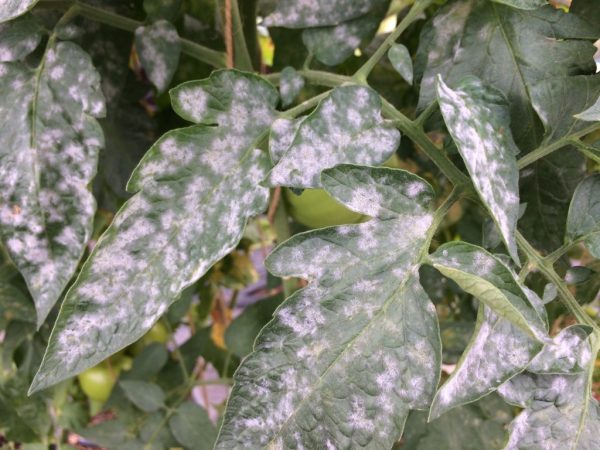The cause of white spots on tomato leaves
White spots on tomato leaves are a wake-up call for a gardener. If you notice white spots on tomatoes, this is a symptom of one of the rather serious diseases. The main reasons for many ailments of cultivated plants are improper care or invasion of pests. The first step is to figure out what you did wrong.

The cause of white spots on tomato leaves
Why tomatoes are sick
The white spot of tomato leaves is immediately noticeable and very difficult to miss. The danger is that in just a couple of days, white spots begin to appear on healthy plants, unless radical measures are taken. First of all, you need to think about what happened after the structural changes in the foliage. Most often, this is preceded by excessive waterlogging of the soil as a result of watering or heavy rainfall or after the seedlings have been rearranged.
The main reasons provoking the appearance of fungal infections:
- waterlogging of the soil;
- insufficient amount of vitamins in the soil, mainly calcium and phosphorus;
- infection;
- elevated temperature, with high air humidity.
Why does infection occur
When tomatoes have white spots on the leaves, this means that you urgently need to look for the cause of the disease and, if possible, carry out treatment. Based on the above, the main reasons for the development of all kinds of diseases and a decrease in productivity are improper care of garden crops.
Fungal infections appear as a result of waterlogged soil, insufficient air exchange, and increased air temperature. Diseases that provoke the appearance of cavities inside the stem and fruits appear as a result of a lack of trace elements and watering.
Description of the most common ailments of the stem and deciduous part
The possible cause of the disease can be determined by the localization of the spotting. Often, when transplanting tomatoes into open ground, white spots appear on the upper leaves when they are exposed to direct sunlight. In this case, the white spot is caused by sunburn. This is because the plants were not hardened before transplanting. As a result of sunburn, tomatoes die very rarely and with normal further care, they can quickly recover and give a normal harvest.
Septoria
The next reason may be septoria, a fungal disease that manifests itself as white spot, localized initially on the lower edges of the deciduous part, and eventually spreads further and leads to damage not only to the stem, but also to the fruit. Most often, infection with fungal spores occurs through infected soil or the seed has already been infected.
Symptoms begin to progress in July when conditions are favorable for spore growth. Spores grow most rapidly in a humid, warm environment.
Mosaic and cladosporia as a wake-up call
Most often, mosaic disease affects tomatoes growing outdoors. Its characteristic feature is the appearance of variegated spots on the leaves. It is impossible to cure it, therefore, if all white or yellow spots have already appeared on the tomatoes, the affected bushes will have to be removed. A mosaic photo of the disease gives an idea of how serious such an ailment is.
Tomato white spot can be the onset of a serious disease such as cladosporia. Over time, the spots turn gray or brown and resemble rot. Not only green shoots and leaves are affected, but also appear on fruits over time if the disease is in an advanced stage.
Powdery mildew

Powdery mildew affects tomatoes in a greenhouse
Most fungal infections of tomatoes are transmitted by spores downwind, and mainly develop when grown in a greenhouse. White spotting of tomatoes can be triggered by powdery mildew.
A white bloom appears on the inside of the leaves. Most often, the disease progresses in plants that are grown in a greenhouse. As a rule, symptoms begin to appear in March, if preventive disinfection of the premises has not been carried out.
Ovary diseases
White spot can be observed at all stages of plant development. The disease can manifest itself not only on the stems and deciduous parts, but also on the fruits. More often, a small area of yellow or green color with a compacted structure is observed near the stalk. This is often the result of too bright lighting. It is recommended to dim the light a little during the flowering period of tomatoes and the immediate ovary, as well as during the ripening of the fruits.
It is necessary to organize optimal ventilation of the greenhouse, regular moderate watering of tomatoes using dressings. Often, in crops grown in a greenhouse, the flesh remains tough, despite the fact that, it would seem, the fruit is fully ripe. The structure may be uneven, wavy in some places and covered with small bumps. Such symptoms are caused by an insufficient amount of potassium or a violation of the temperature regime. The way to deal with the disease is the same as in the previous case.
A viral infection can cause hollow fruits to appear. They remain edible, but the pulp is low in juice. To combat the disease, regular watering with fertilizing is recommended, planting in places without drafts. It is not recommended to use chemicals and herbicides, artificial pollination would be ideal.
Methods for preventing the development of diseases
As such, there is practically no treatment for white spot, basically, these are preventive measures. To be able to prevent fungal infestation, the seed is soaked in a potassium permanganate solution before planting or treated with fungicides. This is the first step towards a good harvest. You also need to take care of the quality of the soil mixture into which the seeds will be sown. It is better to purchase a universal soil in the store, if the soil is taken from the street, then it is better to fry it in the oven.
Such a move will help prevent any infectious disease and pest infestation. To prevent the leaves from becoming covered with white spots when transplanting them into open ground, in advance, about a month in advance, you need to start gradual hardening of the seedlings, exposing them to lighter rooms in the sun, but in no case under direct sunlight. It is important to remember that the stem and foliage are responsible for the processes of photosynthesis. Damage due to sunburn, in one way or another, even with full restoration of the deciduous part and stem, will affect the yield.
In case of burns, the plant can be cured with mineral fertilizers. It is best to transplant tomatoes in cloudy weather and make a shade for them in the first few days. The yield on burnt bushes will be several times less than on completely healthy ones.
What to do if symptoms have already appeared
If white spots have already appeared on the tomatoes, then several treatment options are considered:
- agrotechnical;
- folk methods;
- chemical substances.
It is recommended to use the first two methods to begin with, and if there is no result, then proceed to the use of fungicides. The thing is that any chemical preparation contains toxins that are absorbed by the stem and the fruits themselves. Fruits can be eaten only three weeks after treatment, and fungicides cannot be treated if the site is near a reservoir.
The agrotechnical method involves the removal of all plant residues after harvest. The remains must not be buried; they must be completely destroyed. Complete destruction of affected bushes is the main method of dealing with white spots on tomato leaves. You should also reconsider the care of the culture. With fungal diseases, the main reasons are too warm weather and waterlogging of the soil. These reasons will be the same for both greenhouse and outdoor plants.
Unfortunately, most fungal spores are able to withstand temperature extremes and remain viable for a long time. The first step is to reduce the number of waterings, to once a week. In greenhouses, it is recommended to cover the soil between the plants with dark plastic to prevent the spread of fungal spores through the soil mixture. It is advisable to water with a solution of potassium permanganate, as well as spray the stems and the deciduous part with it. In combination with a manganese solution, a decoction of ash and iodine is used.
One of the most effective folk remedies is watering with garlic broth. Optimum air exchange should be established in the greenhouse. If the reason is excessive moisture and stagnation of air, it is recommended to tie twigs, and lay cardboard under the bushes, try to water without splashing water. For many fungal and infectious diseases, any treatment is useless, therefore it is recommended, when the first symptoms are detected, to completely eradicate all affected plants and process healthy ones.
Not all tomato diseases are treatable. Most of the fungal infections are eliminated by completely removing the affected bushes, in order to avoid contamination of neighboring healthy plants. After removing such cultures, all instruments should be disinfected, as well as processing for healthy sprouts.


